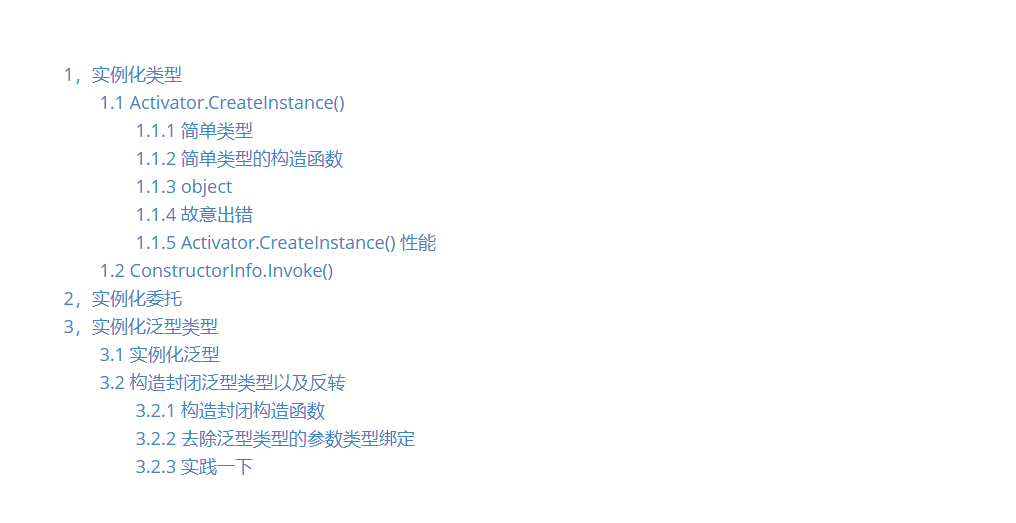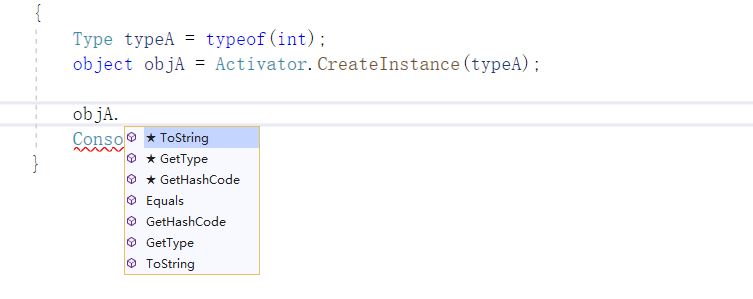前面三篇文章,介绍了使用程序集、获取 Type 类型、使用 Type 类型获取成员信息。
通过前面的学习,我们大概了解到 Assembly、PropertyInfo、FieldInfo、ConstructorInfo、MethodInfo、ParameterInfo、EventInfo、MemberInfo 的存在和输出信息。
从本篇文章,将开始通过反射实例化类型,进行一系列的反射操作实践。
本篇文章,主要讲述实例化类型、实例化委托。

1,实例化类型
从类型(Type)创建实例对象的方式,有两种
- Activator.CreateInstance() 方法 ,操作 类型 Type
- ConstructorInfo.Invoke(),操作 构造函 ConstructorInfo
实例化一个类型时,首先考虑类型的构造函数。
1.1 Activator.CreateInstance()
首先,在 Microsoft Docs 中,这么定义:
使用与指定参数匹配程度最高的构造函数创建指定类型的实例。
这是什么意思呢?
我们来看一下 Activator.CreateInstance() 最常用的两个个重载。
object? CreateInstance(Type type);
object? CreateInstance(Type type, params object[] args);
args 就是实例化类型时,给构造函数传递的参数。因为使用的是 object ,最终实例化是使用到的 构造函数 是 区配程度 最高的。
好了,不扯了,我们来实践一下。
1.1.1 简单类型
Type typeA = typeof(int);
object objA = Activator.CreateInstance(typeA);
通过上面的代码,我们可以很方便的实例化一个简单类型。
当然,你可以看到,创建后的类型是 object 。
那么,问题来了

反射后,少不得一顿装箱拆箱了。
目前来说,我们使用不了 int 的方法了,只能使用 object 。怎么办?
先留着后面再解决呗。
当然,可以直接使用 int ,那我还使用反射干嘛?
int i = 666;
这样不就行了?
如果需要在程序生成后,引用 dll 的代码,我们可以这样做
Assembly ass = Assembly.LoadFrom(@"C:Program FilesdotnetpacksMicrosoft.NETCore.App.Ref3.0.0
ef
etcoreapp3.0System.Runtime.dll");
Type typeA = ass.GetType("System.Int32");
object objA = Activator.CreateInstance(typeA);
1.1.2 简单类型的构造函数
对于 int 这些简单类型,没有别的操作,直接实例化就行,这里例举 DateTime 类型,通过不同的参数,调用构造函数去实例化。
Type typeA = typeof(DateTime);
object objA = Activator.CreateInstance(typeA,2020,1,5);
当然,如果无法找到合适的构造函数来实例化类型,则会弹出 System.MissingMethodException 异常。

1.1.3 object
让我们创建一个类型
public MyClass(object a, object b)
{
}
public MyClass(string a, string b)
{
}
public MyClass(string a, object b)
{
}
通过反射创建实例
Type typeA = typeof(MyClass);
object objA = Activator.CreateInstance(typeA, 2020,666);
Console.WriteLine(typeA.Name);
以上代码并不会报错。
原因有两个,① 类型转换至 object,会携带原类型的信息;② Activator.CreateInstance() 会寻找最优的构造函数。
所以上面创建实例化时,会调用 public MyClass(int a, int b)。没有符合的怎么办?那就调用最优解;
所以上面这点小意思,不会造成任何影响的。
对于简单类型,寻找过程如下
1,寻找相应类型的构造函数
Activator.CreateInstance(typeA, 2020,666),2020 是 typeo(int),666 是 typeof(int)。
最优是 public MyClass(int a, int b)
2,找不到的话,就找可以隐式转换的构造函数
例如 int -> long;
public MyClass(long a, long b)
3,如果没有隐式转换,则 object
public MyClass(object a, object b)
如果都没有符合条件的话,只能报错了;
验证一下
public class MyClass
{
public MyClass(string a, string b) { }
public MyClass(int a, int b) { }
}
class Program
{
static void Main(string[] args)
{
Type typeA = typeof(MyClass);
long a = 666;
long b = 666;
object objA = Activator.CreateInstance(typeA, a, b);
Console.WriteLine(typeA.Name);
Console.ReadKey();
}
}
不出意外的话,上面代码会报错。
1.1.4 故意出错
public class MyClass
{
public MyClass(string a = null) { }
public MyClass(StringBuilder a = null) { }
}
class Program
{
static void Main(string[] args)
{
Type typeA = typeof(MyClass);
object objA = Activator.CreateInstance(typeA, null);
Console.WriteLine(typeA.Name);
Console.ReadKey();
Console.ReadKey();
}
}
如无意外,上面的代码,执行后会报错。
因为当实例化时,参数为 null,有两个符合要求的构造函数。
其它情况下,根据 1.1.3 中,寻找构造函数的步骤,可以大致判断是否会出错。
1.1.5 Activator.CreateInstance() 性能
我们来通过正常的代码实例化一个类型,实声明并且赋值,共 1 千万次。
Stopwatch time = new Stopwatch();
time.Start();
for (int i = 0; i < 1_000_0000; i++)
{
int a = 666;
}
time.Stop();
Console.WriteLine(time.ElapsedMilliseconds);
time.Reset();
time.Restart();
for (int i = 0; i < 1_000_0000; i++)
{
int a = 666;
}
time.Stop();
Console.WriteLine(time.ElapsedMilliseconds);
时间
24
23
使用反射
Type typeA = typeof(int);
Stopwatch time = new Stopwatch();
time.Start();
for (int i = 0; i < 1_000_0000; i++)
{
object objA = Activator.CreateInstance(typeA);
}
time.Stop();
Console.WriteLine(time.ElapsedMilliseconds);
time.Reset();
time.Restart();
for (int i = 0; i < 1_000_0000; i++)
{
object objA = Activator.CreateInstance(typeA);
}
time.Stop();
Console.WriteLine(time.ElapsedMilliseconds);
时间
589
504
500 / 25 = 20,没错,性能相差了 20倍以上。
1.2 ConstructorInfo.Invoke()
ConstructorInfo.Invoke() 调用构造函数的限制性比Activator.CreateInstance() 高,并且是严格对应的。
1.1.4 中,故意出错的代码中,可以看到因为 null 时,有多个构造函数符合条件而导致程序报错。
使用 ConstructorInfo.Invoke() 创建实例进行测试。
public class MyClass
{
public MyClass(string a = null) { Console.WriteLine(6666); }
public MyClass(StringBuilder a = null) { }
}
class Program
{
static void Main(string[] args)
{
// 通过唯一性获取构造函数
// 通过参数类型和数量,获取到唯一的构造函数
ConstructorInfo conStruct = typeof(MyClass).GetConstructor(new Type[] { typeof(string) });
// 传输参数值并且进行实例化
object objA = conStruct.Invoke(new object[] { null });
Console.ReadKey();
}
}
使用 typeof(MyClass).GetConstructor(new Type[] { typeof(string) }); 获取到类型的构造函数,然后使用 ConstructorInfo.Invoke() 实例化。
上面 GetConstructor() 的方法,重载定义如下
public ConstructorInfo? GetConstructor(Type[] types);
通过什么的方法,可以使用 public 构造函数实例化一个类型,如果想调用非 public 的构造函数呢?
可以使用 BindingFlags,这些后面再慢慢学习。
2,实例化委托
使用 Delegate.CreateDelegate() 方法实例化一个委托,使用 Delegate.DynamicInvoke() 调用委托并且传递参数。
使用形式
CreateDelegate(Type, Object, MethodInfo)
Type 是此委托类型,Object 、MethodInfo 是实例类型、方法。
有两种情况,一种是实例方法、一种是静态方法。
我们创建一个委托以及类型
delegate int Test(int a, int b);
public class MyClass
{
public int A(int a, int b)
{
Console.WriteLine("A");
return a + b;
}
public static int B(int a, int b)
{
Console.WriteLine("B");
return a - b;
}
}
Main() 中 实验代码如下
// 绑定实例方法
Delegate d1 = Delegate.CreateDelegate(typeof(Test), new MyClass(), "A");
// 绑定静态方法
Delegate d2 = Delegate.CreateDelegate(typeof(Test), typeof(MyClass), "B");
Console.WriteLine(d1.DynamicInvoke(333,333));
Console.WriteLine(d2.DynamicInvoke(999,333));
Console.ReadKey();
输出
A
666
B
666
3,实例化泛型类型
3.1 实例化泛型
实例化一个泛型类型时,可以按照实例化普通类型过程操作
// 正常
Type type = typeof(List<int>);
object obj = Activator.CreateInstance(type);
// 下面的会报错
Type _type = typeof(List<>);
object _obj = Activator.CreateInstance(_type);
使用 Activator.CreateInstance 方法实例化一个泛型类型时,必须是 已绑定类型参数 的泛型 Type。
List<int> 已绑定 √; List<> 未绑定 ×。
另外,通过 ConstructorInfo.Invoke() 实例化也是一样的。
public class MyClass<T>
{
public MyClass(T a)
{
Console.WriteLine(a);
}
}
class Program
{
static void Main(string[] args)
{
// 正常
ConstructorInfo type = typeof(MyClass<int>).GetConstructor(new Type[] { typeof(int) });
object obj = type.Invoke(new object[] { 666 });
Console.ReadKey();
}
}
3.2 构造封闭泛型类型以及反转
3.2.1 构造封闭构造函数
有时候,传递过来的恰恰是 List<> 呢?
使用 Type.MakeGenericType(Type),
我们可以这样多一步,将未绑定类型参数的泛型 Type,转为封闭的 泛型 Type。
Type type = typeof(List<>);
// 构建泛型 Type
Type _type = type.MakeGenericType(typeof(int));
object _obj = Activator.CreateInstance(_type);
3.2.2 去除泛型类型的参数类型绑定
使用 Type.GetGenericTypeDefinition() 方法可以去除一个已绑定参数类型的泛型类型的参数类型。
Type type = typeof(List<int>);
Console.WriteLine(type.FullName);
// 构建泛型 Type
Type _type = type.GetGenericTypeDefinition();
Console.WriteLine(_type.FullName);
输出
System.Collections.Generic.List`1[[System.Int32, System.Private.CoreLib, Version=4.0.0.0, Culture=neutral, PublicKeyToken=7cec85d7bea7798e]]
System.Collections.Generic.List`1
List<int> 变成了 List<>。
3.2.3 实践一下
上面介绍了泛型类型的实例化和两个关于参数类型的使用,下面来实践一下
static void Main(string[] args)
{
Type typeA = typeof(Console);
Type typeB = typeof(List<>);
Type typeC = typeof(List<int>);
去除泛型类型绑定的参数类型(typeA);
去除泛型类型绑定的参数类型(typeB);
去除泛型类型绑定的参数类型(typeC);
Console.ReadKey();
}
/// <summary>
/// 将 List<T> 转为 List<>
/// </summary>
/// <param name="type"></param>
/// <returns></returns>
public static (bool, Type) 去除泛型类型绑定的参数类型(Type type)
{
// 检查是否泛型类型
if (type.IsGenericType == false)
{
Console.WriteLine("此类型不是泛型类型");
return (false, type);
}
// 检查是否是未绑定参数类型的泛型类型
if (type.IsGenericTypeDefinition)
{
Console.WriteLine("本来就不需要处理");
return (true, type);
}
Type _type = type.GetGenericTypeDefinition();
Console.WriteLine("处理完毕");
return (true, _type);
}
}
此文仅授权《NCC 开源社区》订阅号发布